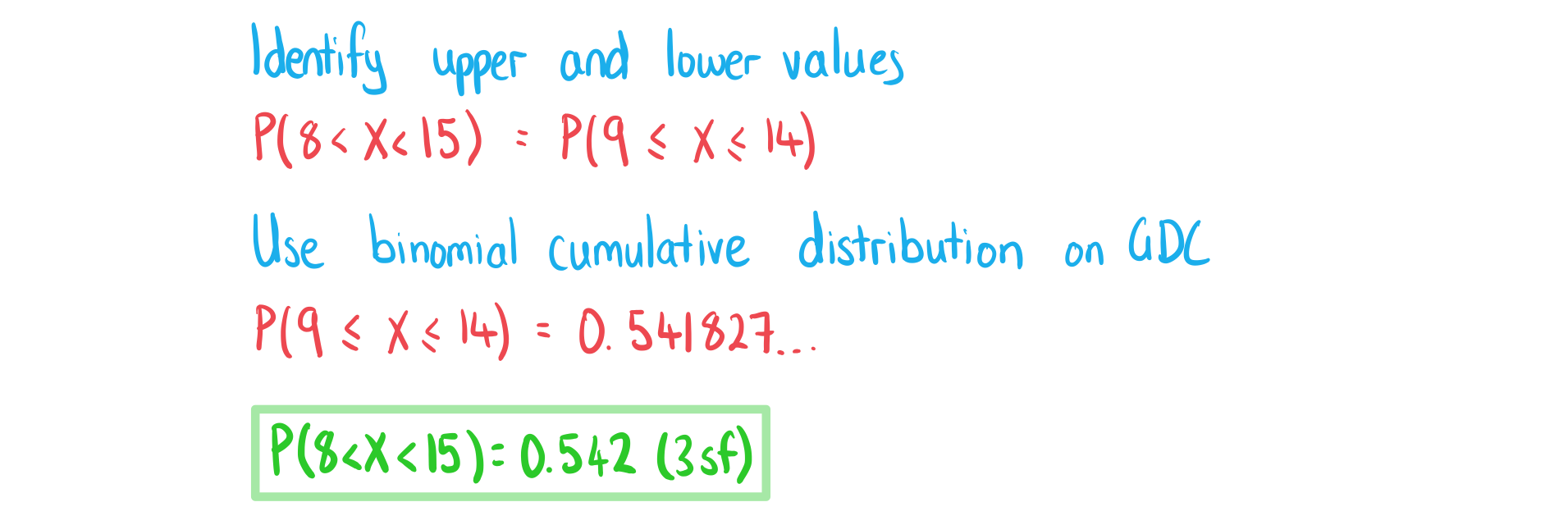Did this video help you?
Calculating Binomial Probabilities (DP IB Maths: AA HL): Revision Note
Calculating Binomial Probabilities
Throughout this section we will use the random variable . For binomial, the probability of
taking a non-integer or negative value is always zero. Therefore any values of
mentioned in this section will be assumed to be non-negative integers.
How do I calculate P(X = x): the probability of a single value for a binomial distribution?
- You should have a GDC that can calculate binomial probabilities
- You want to use the "Binomial Probability Distribution" function
- This is sometimes shortened to BPD, Binomial PD or Binomial Pdf
- You will need to enter:
- The 'x' value - the value of x for which you want to find
- The 'n' value - the number of trials
- The 'p' value - the probability of success
- The 'x' value - the value of x for which you want to find
- Some calculators will give you the option of listing the probabilities for multiple values of x at once
- There is a formula that you can use but you are expected to be able to use the distribution function on your GDC
How do I calculate P(a ≤ X ≤ b): the cumulative probabilities for a binomial distribution?
- You should have a GDC that can calculate cumulative binomial probabilities
- Most calculators will find
- Some calculators can only find
- The identities below will help in this case
- Most calculators will find
- You should use the "Binomial Cumulative Distribution" function
- This is sometimes shortened to BCD, Binomial CD or Binomial Cdf
- You will need to enter:
- The lower value - this is the value a
- This can be zero in the case
- This can be zero in the case
- The upper value - this is the value b
- This can be n in the case
- This can be n in the case
- The 'n' value - the number of trials
- The 'p' value - the probability of success
- The lower value - this is the value a
How do I find probabilities if my GDC only calculates P(X ≤ x)?
- To calculate P(X ≤ x) just enter x into the cumulative distribution function
- To calculate P(X < x) use:
which works when X is a binomial random variable
- P(X < 5) = P(X ≤ 4)
- To calculate P(X > x) use:
which works for any random variable X
- P(X > 5) = 1 - P(X ≤ 5)
- To calculate P(X ≥ x) use:
which works when X is a binomial random variable
- P(X ≥ 5) = 1 - P(X ≤ 4)
- To calculate P(a ≤ X ≤ b) use:
which works when X is a binomial random variable
- P(5 ≤ X ≤ 9) = P(X ≤ 9) - P(X ≤ 4)
What if an inequality does not have the equals sign (strict inequality)?
- For a binomial distribution (as it is discrete) you could rewrite all strict inequalities (< and >) as weak inequalities (≤ and ≥) by using the identities for a binomial distribution
and
- For example: P(X < 5) = P(X ≤ 4) and P(X > 5) = P(X ≥ 6)
- It helps to think about the range of integers you want
- Identify the smallest and biggest integers in the range
- If your range has no minimum or maximum then use 0 or n
- P(5 < X ≤ 9) = P(6 ≤ X ≤ 9)
- P(5 ≤ X < 9) = P(5 ≤ X ≤ 8)
- P(5 < X < 9) = P(6 ≤ X ≤ 8)
Examiner Tip
- If the question is in context then write down the inequality as well as the final answer
- This means you still might gain a mark even if you accidentally type the wrong numbers into your GDC
Worked example
The random variable . Find:
i)

ii)

iii)


You've read 0 of your 5 free revision notes this week
Sign up now. It’s free!
Did this page help you?
